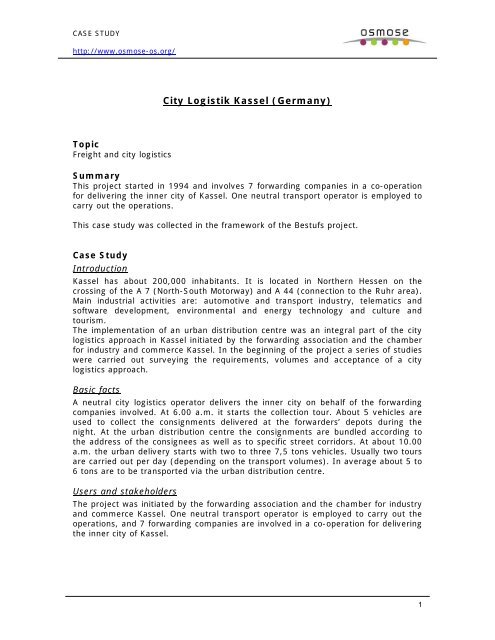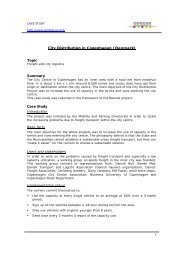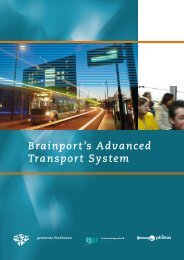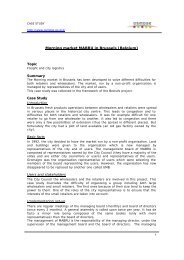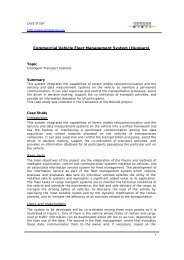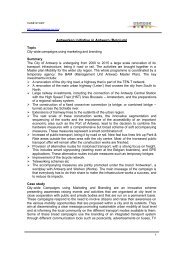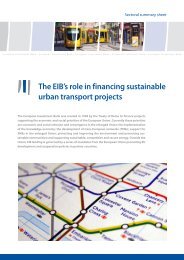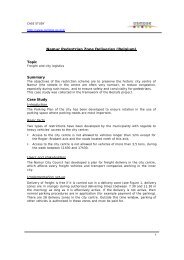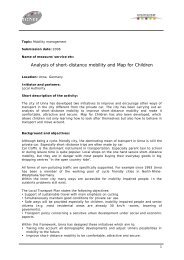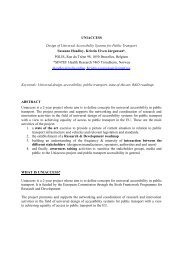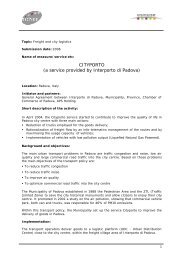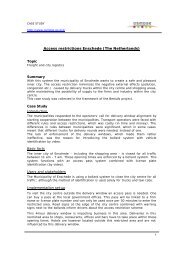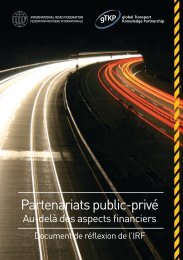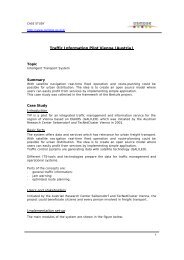kassel_urb freight plat.pdf - Osmose
kassel_urb freight plat.pdf - Osmose
kassel_urb freight plat.pdf - Osmose
You also want an ePaper? Increase the reach of your titles
YUMPU automatically turns print PDFs into web optimized ePapers that Google loves.
CASE STUDY<br />
http://www.osmose-os.org/<br />
City Logistik Kassel (Germany)<br />
Topic<br />
Freight and city logistics<br />
Summary<br />
This project started in 1994 and involves 7 forwarding companies in a co-operation<br />
for delivering the inner city of Kassel. One neutral transport operator is employed to<br />
carry out the operations.<br />
This case study was collected in the framework of the Bestufs project.<br />
Case Study<br />
Introduction<br />
Kassel has about 200,000 inhabitants. It is located in Northern Hessen on the<br />
crossing of the A 7 (North-South Motorway) and A 44 (connection to the Ruhr area).<br />
Main industrial activities are: automotive and transport industry, telematics and<br />
software development, environmental and energy technology and culture and<br />
tourism.<br />
The implementation of an <strong>urb</strong>an distribution centre was an integral part of the city<br />
logistics approach in Kassel initiated by the forwarding association and the chamber<br />
for industry and commerce Kassel. In the beginning of the project a series of studies<br />
were carried out surveying the requirements, volumes and acceptance of a city<br />
logistics approach.<br />
Basic facts<br />
A neutral city logistics operator delivers the inner city on behalf of the forwarding<br />
companies involved. At 6.00 a.m. it starts the collection tour. About 5 vehicles are<br />
used to collect the consignments delivered at the forwarders’ depots during the<br />
night. At the <strong>urb</strong>an distribution centre the consignments are bundled according to<br />
the address of the consignees as well as to specific street corridors. At about 10.00<br />
a.m. the <strong>urb</strong>an delivery starts with two to three 7,5 tons vehicles. Usually two tours<br />
are carried out per day (depending on the transport volumes). In average about 5 to<br />
6 tons are to be transported via the <strong>urb</strong>an distribution centre.<br />
Users and stakeholders<br />
The project was initiated by the forwarding association and the chamber for industry<br />
and commerce Kassel. One neutral transport operator is employed to carry out the<br />
operations, and 7 forwarding companies are involved in a co-operation for delivering<br />
the inner city of Kassel.<br />
1
CASE STUDY<br />
http://www.osmose-os.org/<br />
Implementation set-up<br />
The city logistics operator receives the transport volumes in the morning via e-mail.<br />
The delivery takes place the same day. In case that a delivery cannot take place the<br />
city logistics operator informs the respective forwarder (from whom he got the<br />
transport order) via telephone. The processes of collection, commissioning, and<br />
delivery are not technically supported and are taking place on the basis of receipts.<br />
The services from the neutral operator (transport and transhipment) are being paid<br />
on the basis of a specific city logistics tariff. The operator is invoicing his services<br />
with each forwarder separately. According to statements and surveys carried out the<br />
approach shows no significant change on the cost side for the forwarding companies<br />
involved (neither benefit nor extra costs compared to the usual delivery services). No<br />
specific institutional measures have been foreseen to support the approach.<br />
Results<br />
According to studies carried out the <strong>urb</strong>an distribution centre is seen as unavoidable<br />
if the goods bound for the city are to be bundled more efficiently, which is the main<br />
aim of the Kassel city logistics scheme. The consignees in the inner city do not state<br />
any differences in service quality compared to the former delivery scheme.<br />
The main success of the scheme is that the transports can be bundled without any<br />
extra costs or inconveniences for neither the involved companies nor the consignees.<br />
On the other hand the general public benefits from fewer trips, thus fewer vehicles<br />
and fewer emissions. The benefits of the involved transport operators and forwarders<br />
are intangibles: the image of being an innovative and responsible company.<br />
A success factor in the beginning of the scheme was the motivation of the partners<br />
involved. Especially, the drivers of the neutral operator have to fulfil additional<br />
service requirements of the consignees.<br />
Web links<br />
http://www.bestufs.net/<br />
Author contact details<br />
Author who did the material collection for BESTUFS:<br />
Marcel Huschebeck, PTV<br />
City or region<br />
Kassel<br />
Country<br />
Germany<br />
Submission date<br />
2002<br />
2


